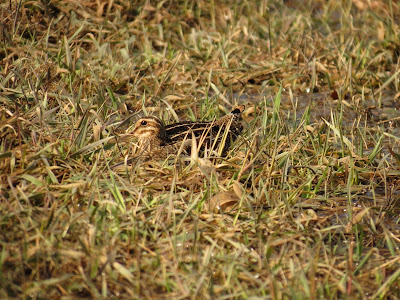This is the first time I've ever been able to watch a snipe feeding at close range, and I was excited to be able to show a number of friends their first snipe.
The bird stopped feeding and sat still any time I got close enough for decent pictures, but fed happily when I retreated a little further away. I was able to get the following video of it feeding:
The views were much better than it seems from this video, and I was glad to see the characteristic bobbing motion of feeding snipe. A number of birds bob or wag their tail repetitively, and I've often wondered why. Many of these species are characteristically found along rivers and streams (Dippers, Grey Wagtail, Spotted and Common Sandpipers, Louisiana Waterthrush, Phoebes), and my personal theory without any research has long been that the bobbing motion helps them blend in with the rhythmic movement of the water.
I decided to look it up today, and it seems there is very little information about this behavior. Still, at least three studies (on Eastern Phoebe, Black Phoebe and White Wagtail) have suggested that tail bobbing is either a signal to a predator that the bird is currently aware of the predator, or a general signal to predators that the bird is healthy, vigilant and agile.
This does not seem to explain bobbing in snipe. They are generally invisible in dense cover anyways, mainly only bob while feeding, and would seemingly be better served by simply sitting tight with their excellent camouflage.
While looking for more information I stumbled upon some interesting speculation based on the fact that snipe have eyes almost exactly on the sides of their heads, leaving them with little to no binocular vision. Perhaps the bobbing motion allows the bird to achieve some parallax to better locate food. However, I find this explanation unlikely for two reasons. Snipe mainly detect prey underground with their long sensitive bill, making improved depth perception fairly useless. Also, the bobbing motion seems mostly restricted to the body with the head held relatively still, exactly the opposite of what you would predict from this hypothesis.
I suspect the main explanation is much simpler: the movement causes the bird's prey to move around so it can be detected and caught. Still, I would like to see this investigated more scientifically at some point.
If anybody has any other insights or information explaining this behaviour please let me know!




No comments:
Post a Comment